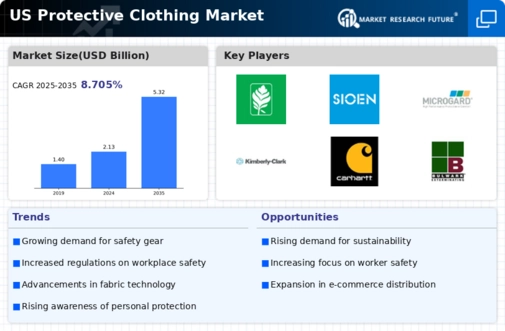The protective clothing market is characterized by a dynamic competitive landscape, driven by increasing safety regulations and a growing emphasis on worker protection across various industries. Key players such as DuPont (US), 3M (US), and Honeywell (US) are at the forefront, leveraging innovation and strategic partnerships to enhance their market positions. DuPont (US) focuses on developing advanced materials that offer superior protection, while 3M (US) emphasizes its commitment to sustainability and eco-friendly products. Honeywell (US) is actively pursuing digital transformation initiatives to improve operational efficiency and customer engagement, collectively shaping a competitive environment that prioritizes safety and innovation.
In terms of business tactics, companies are increasingly localizing manufacturing to reduce lead times and enhance supply chain resilience. The market structure appears moderately fragmented, with several players vying for market share. However, the collective influence of major companies like MSA Safety (US) and Lakeland Industries (US) is notable, as they implement strategies that optimize their supply chains and enhance product offerings, thereby intensifying competition.
In October 2025, MSA Safety (US) announced the launch of a new line of flame-resistant clothing designed specifically for the oil and gas sector. This strategic move is significant as it addresses the growing demand for specialized protective gear in high-risk industries, potentially positioning MSA Safety (US) as a leader in this niche market. The introduction of this product line not only enhances their portfolio but also aligns with industry trends towards increased safety standards.
In September 2025, Lakeland Industries (US) expanded its manufacturing capabilities by investing in a new facility in Texas. This expansion is crucial as it allows Lakeland Industries (US) to better serve the growing demand for protective clothing in the southern US, where industrial activities are on the rise. The strategic investment reflects a proactive approach to meet regional needs and enhance supply chain efficiency, which could lead to increased market share.
In August 2025, 3M (US) entered into a partnership with a leading technology firm to integrate AI into its product development processes. This collaboration is indicative of a broader trend towards digitalization within the industry, as companies seek to leverage technology to enhance product innovation and operational efficiency. The integration of AI could streamline design processes and improve the performance of protective clothing, thereby reinforcing 3M's competitive edge.
As of November 2025, current trends in the protective clothing market include a strong focus on sustainability, digitalization, and the integration of advanced technologies such as AI. Strategic alliances are increasingly shaping the competitive landscape, enabling companies to pool resources and expertise. Looking ahead, it appears that competitive differentiation will evolve from traditional price-based competition to a focus on innovation, technological advancements, and supply chain reliability. This shift may redefine market dynamics, compelling companies to invest in R&D and sustainable practices to maintain their competitive positions.





















Leave a Comment